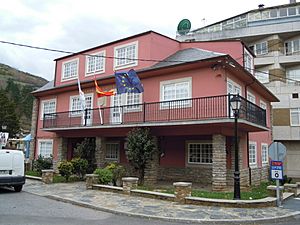As Nogais facts for kids
As Nogais is a small town in Galicia, a region in northwest Spain. It's part of the Lugo province. As Nogais is about 57 kilometers (35 miles) away from the city of Lugo. It's also part of an area called Los Ancares Lucenses. In 2009, about 1,381 people lived here.
Contents
Geography of As Nogais
As Nogais is located in a beautiful area. It sits at the southern base of the Sierra de los Ancares mountains. It also lies in the valley of the Navía River. This river starts nearby in Piedrafita del Cebrero.
The area of As Nogais is quite large, covering about 112.4 square kilometers (43.4 square miles). However, not many people live there. It has a very low population density, with fewer than 15 people per square kilometer.
Mountains and Rivers
The highest points in As Nogais are in the Sierra de los Ancares. These include hills like Travesa, Chan Pintinidoira, and Pereira. Their heights range from 1,000 to 2,000 meters (3,280 to 6,560 feet). To the south and southwest, the land rises even higher. Pico do Corvo is the highest point, reaching 1,387 meters (4,550 feet).
The Navía River flows through As Nogais. It runs from the southwest to the northwest. Other smaller rivers and streams join the Navía here. These include the Valdeparada River and the Boullón stream.
Climate
The weather in As Nogais is generally cool. Winters are cold, and summers are mild. The average temperature throughout the year is about 9 °C (48 °F).
History of As Nogais
As Nogais has a long history. People have lived here for a very long time.
Ancient Settlements
Long ago, there were ancient settlements from the Castro culture. These were fortified villages built by early people. Examples include the forts of Vilabol, Vilaesteva, and Quintá.
A famous Roman bridge, called Ponte Naviae, is also located here. It was part of an important Roman road. This road connected the cities of Braga and Astorga.
Defending the Region
As Nogais was an important entry point into Galicia from Castile. The climb to Piedrafita, a difficult mountain pass, began here. Because of its location, the area was defended by several towers and castles. These included the Doncos tower and the castles of Doiras and Valcarce.
In the 1300s, Doncos tower belonged to Garcia Rodríguez de Valcarce. Later, in the 1400s, it was owned by the Earl of Ayala and the Countess of Monterrey. By 1603, when Fernando de Toledo owned it, the tower was already abandoned.
Later History
During the Peninsular War (also known as the War of Independence) in Spain, French troops caused damage. They burned Doncos and other places in the area.
Later, in 1835, local people formed groups of volunteers. They helped to fight against the Carlists. The Carlists were a political group who wanted a different king for Spain.
See also
 In Spanish: Los Nogales (Lugo) para niños
In Spanish: Los Nogales (Lugo) para niños


